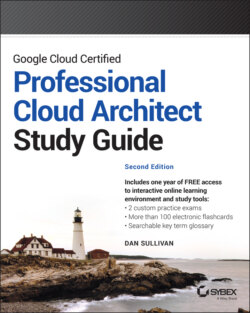Читать книгу Google Cloud Certified Professional Cloud Architect Study Guide - Dan Sullivan - Страница 65
Data Lifecycle Management
ОглавлениеWhen assessing the application design and cost implications of business requirements, consider how to manage storage costs. Storage options lie on a spectrum from short-term to archival storage.
Memorystore is a cache, and data should be kept in cache only if it is likely to be used by an application in the very near future. The purpose of this storage is to reduce the latency of accessing data.Caches are not durable. Data stored in Memorystore can disappear at any time. Only data that can be retrieved from another source or regenerated should be stored in a cache.
Databases, like CloudSQL and Firestore, store data that needs to be persistently stored and readily accessed by an application or user. Data should be stored in the database when it could possibly be queried or updated. When data is no longer required to be queried or updated, it can be exported and stored in object storage.
In the case of time-series databases, data may be aggregated by larger time spans as time goes on. For example, an application may collect performance metrics every minute. After three days, there is no need to query to the minute level of detail, and data can be aggregated to the hour level. After one month, data can be aggregated to the day level. This incremental aggregation will save space and improve response times for queries that span large time ranges.
Object storage is often used for unstructured data and backups. Standard Storage class should be used for frequently accessed data. If data is accessed at most once a month, then Nearline storage can be used. When data is not likely to be accessed more than once in 90 days, then Coldline storage should be used. Archive storage is appropriate for objects that are not accessed more than once per year.
Consider how to take advantage of Cloud Storage's lifecycle management features, which allow you to specify actions to perform on objects when specific events occur. The two actions supported are deleting an object or changing its storage class. Standard Class storage objects can be migrated to either Nearline, Coldline, or Archive storage. Nearline storage can migrate to Coldline storage or Archive storage. Coldline storage can be migrated to Archive storage. DRA Storage can be transitioned to the other storage classes.
Lifecycle conditions can be based on the following:
The age of an object
When it was created, including CreatedBefore and CustomTimeBefore conditions
Days since a custom time metadata field on an object
The object's storage class
The number of versions of an object as well as the number of days since the object became noncurrent
Whether or not the object is “live” (an object in nonversions bucketed is “live”; archived objects are not live)
Storage class
You can monitor data lifecycle management either by using Cloud Storage usage logs or by enabling Pub/Sub notifications for Cloud Storage buckets. The latter will send a message to a Pub/Sub topic when an action occurs.
